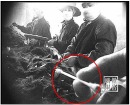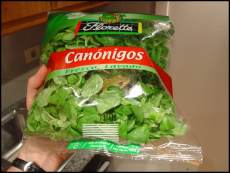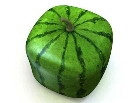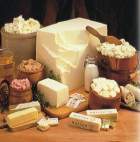Hair-Made Soy Sauce: An Update —
Status: Gross news

Back in January 2004 I posted a
short entry about a factory in China that had been caught making soy sauce out of human hair. I also mentioned the incident in
Hippo Eats Dwarf (p.76). Now
more gruesome details have emerged, published in the
Internet Journal of Toxicology (link via
Boing Boing):
In late 2003, there was an alternatively produced soy sauce named "Hongshuai Soy Sauce" in China. The soy sauce was marketed as “blended using latest bioengineering technology” by a food seasoning manufacturer, suggesting that the soy sauce was not generated in a traditional way using soy and wheat. The Hongshuai Soy Sauce was sold at a relatively low price in Mainland China and became very popular among the public. The people found its taste to be similar to other brands. Because of its low price, many catering services in schools and colleges decided to use this new product.
An investigation led by TV journalists then revealed why the soy sauce was so cheap. It was being manufactured from an amino acid powder (or syrup) bought from a manufacturer in Hubei province:
When asking how the amino acid syrup (or powder) was generated, the manufacturer replied that the powder was generated from human hair. Because the human hair was gathered from salon, barbershop and hospitals around the country, it was unhygienic and mixed with condom, used hospital cottons, used menstrual cycle pad, used syringe, etc. After filtered by the workers, the hair would then cut small for being processed into amino acid syrup. The technicians admitted that they would not consume the human-hair soy sauce because the dirty and unhygienic hair was used to make amino acid syrup. A quality monitoring staff also revealed that though the hair may not be toxic itself, it definitely consisted of bacteria and other micro-organisms.
Lovely. But what the article doesn't mention, but which I believe to be true, is that soy sauce isn't the only food product made out of this cheap hair-made amino acid powder. The stuff is also sold in large quantities to the
bakery industry which uses it as a source of L-cysteine to make dough softer and more elastic. Think about that next time you're chewing on a bagel.

 A lot of sites have been linking to this photo of a frog inside a bag of salad. Could the photo be real? Well, I don't think it's photoshopped, this being a case where it would be a lot easier to stick a frog inside a bag rather than go to the trouble of photoshopping it in. But there have been reported cases in the past of frogs showing up inside packaged salads. For instance, a few months ago (April 12, 2006) The Daily Telegraph in Australia reported a case:
A lot of sites have been linking to this photo of a frog inside a bag of salad. Could the photo be real? Well, I don't think it's photoshopped, this being a case where it would be a lot easier to stick a frog inside a bag rather than go to the trouble of photoshopping it in. But there have been reported cases in the past of frogs showing up inside packaged salads. For instance, a few months ago (April 12, 2006) The Daily Telegraph in Australia reported a case:  Card Trick
Card Trick Square Watermelon
Square Watermelon The Butter Trough, located in Atlanta, Georgia, is a great concept for a restaurant. First of all, the menu is simple. They only serve bread, butter, and sweet tea. But best of all, it's all free! It's the world's first advertiser-supported restaurant:
The Butter Trough, located in Atlanta, Georgia, is a great concept for a restaurant. First of all, the menu is simple. They only serve bread, butter, and sweet tea. But best of all, it's all free! It's the world's first advertiser-supported restaurant:  Back in January 2004 I posted a short entry about a factory in China that had been caught making soy sauce out of human hair. I also mentioned the incident in Hippo Eats Dwarf (p.76). Now more gruesome details have emerged, published in the Internet Journal of Toxicology (link via Boing Boing):
Back in January 2004 I posted a short entry about a factory in China that had been caught making soy sauce out of human hair. I also mentioned the incident in Hippo Eats Dwarf (p.76). Now more gruesome details have emerged, published in the Internet Journal of Toxicology (link via Boing Boing):  Vienna boasts the world's only vegetable orchestra. Members of this orchestra play only instruments made out of vegetables. Among their instruments: the cuke-o-phon, the radish-marimba, and the carrot-flute. (A few kitchen utensils such as knives and mixers are also used, on occasion.) And I love this part of the concept: "the instruments are subsequently made into a soup so that the audience can then enjoy them a second time"
Vienna boasts the world's only vegetable orchestra. Members of this orchestra play only instruments made out of vegetables. Among their instruments: the cuke-o-phon, the radish-marimba, and the carrot-flute. (A few kitchen utensils such as knives and mixers are also used, on occasion.) And I love this part of the concept: "the instruments are subsequently made into a soup so that the audience can then enjoy them a second time" The Alvin Sun-Advertiser reports on a rare hybrid found by a local gardener — a tomato-cucumber. They're calling it a 'Cumato':
The Alvin Sun-Advertiser reports on a rare hybrid found by a local gardener — a tomato-cucumber. They're calling it a 'Cumato':  The latest scandal in the world of French gourmet cuisine: the use of artificial bottled flavors (aka arômes artificiels) to substitute for high-end ingredients such as truffles, wild mushroom, caviar, prawn, crab, shallot, scallop, saffron, and even wine. The London Times reports:
The latest scandal in the world of French gourmet cuisine: the use of artificial bottled flavors (aka arômes artificiels) to substitute for high-end ingredients such as truffles, wild mushroom, caviar, prawn, crab, shallot, scallop, saffron, and even wine. The London Times reports:  Todd emailed me a link to this Phoenix New Times article about rogue chef "Kaz" Yamamoto, whose specialty is creating dishes from "meat, game and vegetation that's considered off limits, immoral or even illegal." We're talking about dishes such as Tenderloin of Bichon Frise, monkey brain stew, Arizona saguaro cactus salad, Yosemite brown bear, rhino genitals, giraffe tongue, Sea World sea lion (supposedly obtained by bribing a Sea World employee), etc. Yamamoto even claims to serve human flesh, obtained by paying Mexican immigrants a handsome sum for their kidney, arm, or leg. These delicacies are all served to a rich and powerful clientele who have a taste for forbidden food.
Todd emailed me a link to this Phoenix New Times article about rogue chef "Kaz" Yamamoto, whose specialty is creating dishes from "meat, game and vegetation that's considered off limits, immoral or even illegal." We're talking about dishes such as Tenderloin of Bichon Frise, monkey brain stew, Arizona saguaro cactus salad, Yosemite brown bear, rhino genitals, giraffe tongue, Sea World sea lion (supposedly obtained by bribing a Sea World employee), etc. Yamamoto even claims to serve human flesh, obtained by paying Mexican immigrants a handsome sum for their kidney, arm, or leg. These delicacies are all served to a rich and powerful clientele who have a taste for forbidden food.  A rare heart-shaped potato has been found by Linda Greene of Moon Township, Pa. She found it in a sack of potatoes back in February and emailed the Idaho Potato Commission about it in March. For some reason it's only making headlines now. What makes the discovery of the potato strange is that irregularly shaped potatoes are supposed to be removed during the sorting process and used for french fries. The potato commission president said: "I would guarantee someone saw it and thought, 'This is cool, we'll let this go through.'... Typically, unique shapes will go into processing _ dehydrated or cut up into french fries." To those who suggest the love spud is a plant (pun intended), being used by the commission to drum up publicity, the commission president says, "We didn't plant it. We'll have to start sorting for heart-shaped potatoes." (Thanks to Big Gary for the story)
A rare heart-shaped potato has been found by Linda Greene of Moon Township, Pa. She found it in a sack of potatoes back in February and emailed the Idaho Potato Commission about it in March. For some reason it's only making headlines now. What makes the discovery of the potato strange is that irregularly shaped potatoes are supposed to be removed during the sorting process and used for french fries. The potato commission president said: "I would guarantee someone saw it and thought, 'This is cool, we'll let this go through.'... Typically, unique shapes will go into processing _ dehydrated or cut up into french fries." To those who suggest the love spud is a plant (pun intended), being used by the commission to drum up publicity, the commission president says, "We didn't plant it. We'll have to start sorting for heart-shaped potatoes." (Thanks to Big Gary for the story)
 Speaking of fake Irish bars, now it's possible to have an instant fake British pub, anywhere you like. It's advertised as "the Worlds first fully functioning Mobile Inflatable Pub." This comes from the same people who brought us the world's first inflatable church. Ideally it should come with a bartender who fakes a British accent.
Speaking of fake Irish bars, now it's possible to have an instant fake British pub, anywhere you like. It's advertised as "the Worlds first fully functioning Mobile Inflatable Pub." This comes from the same people who brought us the world's first inflatable church. Ideally it should come with a bartender who fakes a British accent.
 I've posted before about theories that microwaved food is bad for you, but this is slightly different. Some guy has posted pictures of his granddaughter's science fair project in which she tested the effect microwaved water would have on a plant. The result: the plant died. (Yes, the water had been cooled before she watered the plant with it.) But the plant given water that had been boiled on a stove did just fine. So what does this prove? That microwaved water is toxic? Not necessarily. The guy notes:
I've posted before about theories that microwaved food is bad for you, but this is slightly different. Some guy has posted pictures of his granddaughter's science fair project in which she tested the effect microwaved water would have on a plant. The result: the plant died. (Yes, the water had been cooled before she watered the plant with it.) But the plant given water that had been boiled on a stove did just fine. So what does this prove? That microwaved water is toxic? Not necessarily. The guy notes: